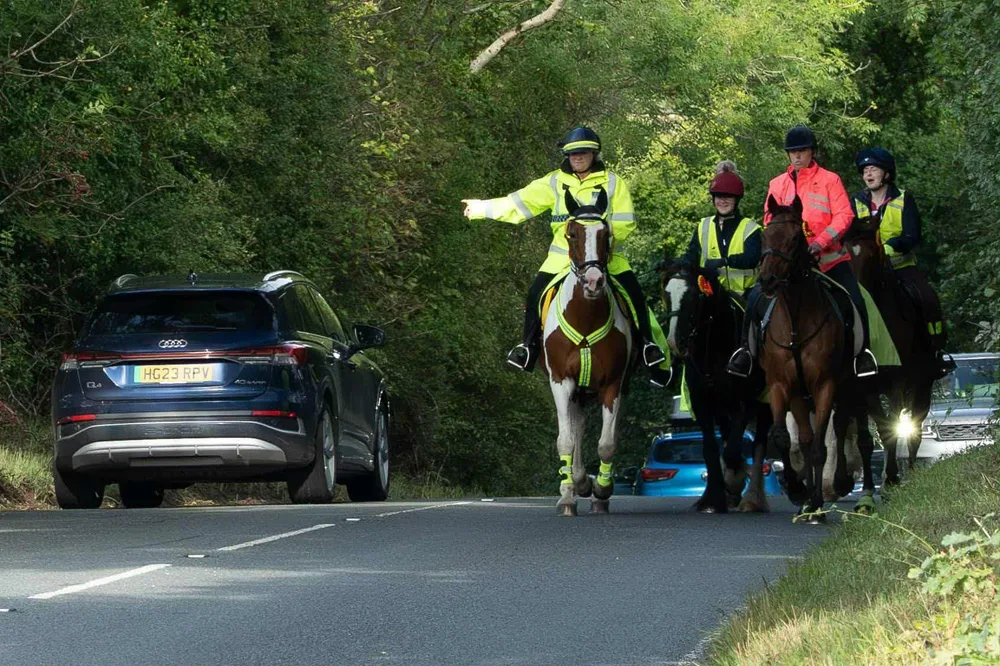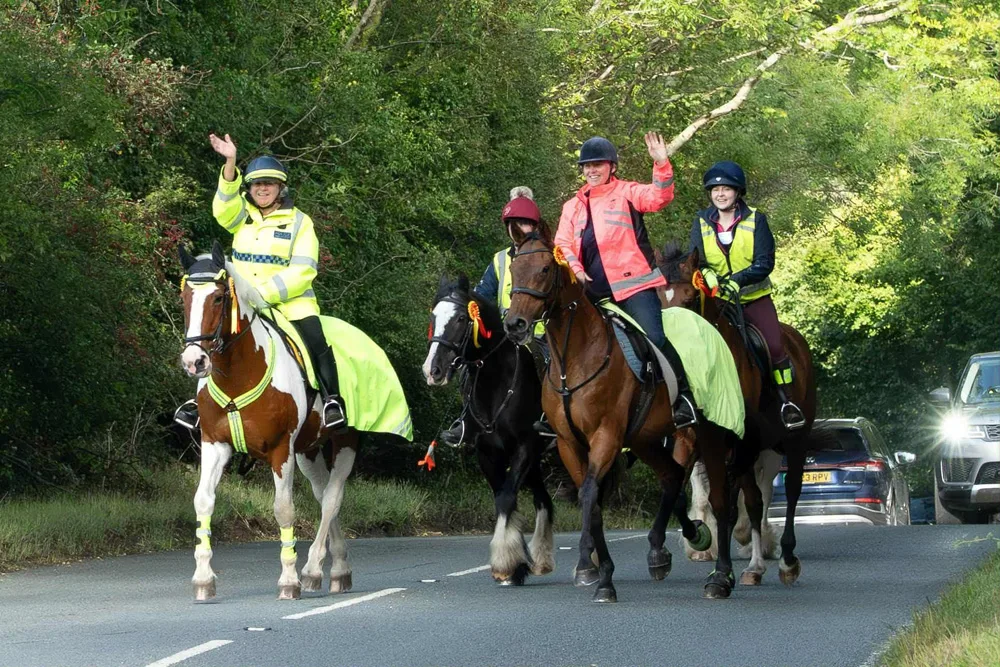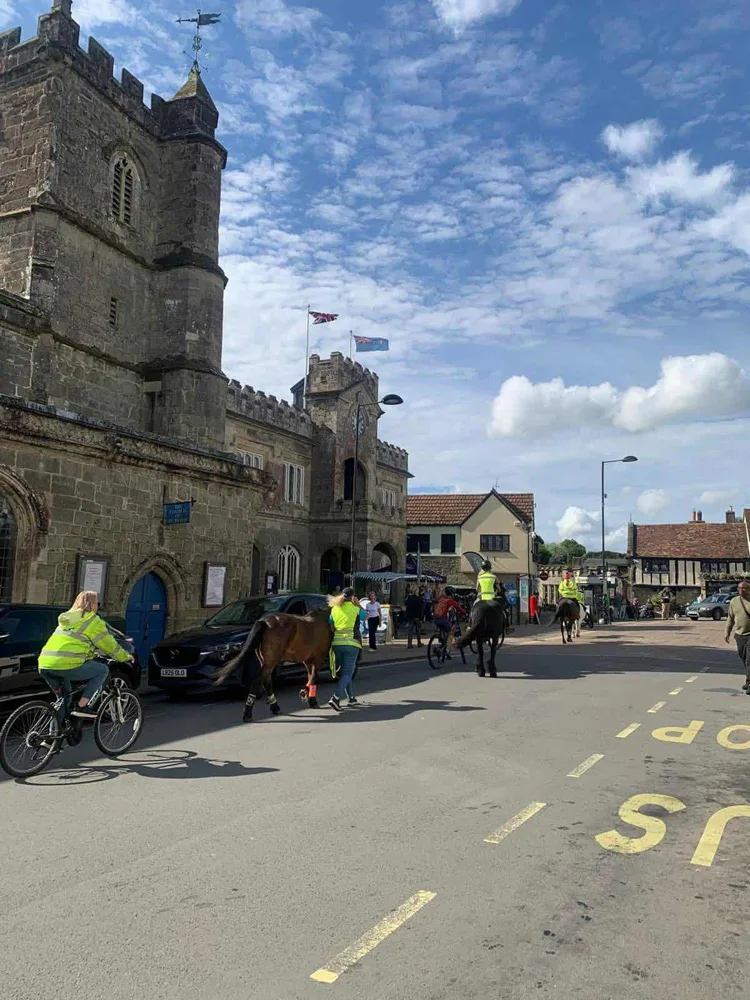Near misses and road rage are on the rise – North Dorset riders saddled up to raise awareness and urge drivers to slow down before it’s too late

Rug or no rug. Shoes or no shoes. Bit or bitless … The horse world rarely agrees on anything.
Except this: every rider has had at least one terrifying moment on the road. And most of us have had far more than one.
The Sass Queen really enjoys hacking, merrily mooching about the countryside (who am I kidding – she doesn’t know how to mooch. She marches). She is, thankfully, totally bomb-proof in traffic – trains, low flying helicopters, tractors, cyclists, you name it and she won’t bat an eyelid at it. Unfortunately, we’ve both been subjected to drivers putting us in dangerous situations, often due to their impatience at having to wait just a few extra seconds to carry on their journey. Incidents like this, especially on young or green horses, can result in a lifelong fear of being in the road and ultimately cause dangerous behaviour, often through no fault of their own.
Two horses killed a week
September marked Shaftesbury’s first Pass Wide and Slow (PWAS) campaign, organised by Sandra Stevens and her friends Alice Wood and Georgie Faulkner-Bryant. Pass Wide and Slow, a national campaign for horse and rider safety, was founded in 2015 by Debbie Smith, after a car frightened her horse by driving too close – a fear he never got over.The aim is to raise awareness on the safest way to pass horses on the public highway. In 2023 there were 3,383 road incidents involving horses: 66 horses died, 86 were injured and three people died.
Of these incidents, 85 per cent were caused by vehicles passing too closely or too fast. Riders are frequently subject to road rage or abuse.
Sandra’s driving force (excuse the pun…) to organise the PWAS ride was due to the massive increase in bad driving instances she’s experienced while riding her horse Flo. An experienced horsewoman, having progressed through the Pony Club to competing in endurance competitions, Sandra enjoys exploring the North Dorset countryside near her home with Flo, a tricoloured Belgium Warmblood.
‘I live on the B3091, which runs from Sturminster Newton to Shaftesbury. I have to ride along the road to get to the local bridleways which are, sadly, very few and far between in North Dorset. On average, two horses are killed a week on public highways: I don’t want my horse to become one of those statistics.’
Sandra recently went riding with her friends Alice and Georgie and mentioned she would like to organise a PWAS event – they both readily agreed to help, she says: ‘We’d all had bad experiences while riding on the road – I’ve been driven at, shouted and sworn at, had vehicles rev up and drivers blasting their horns … I wanted to educate other road users.’
Last year Sandra invested in a hatcam, and regularly reports issues to Dorset Police’s ‘Operation Snap’ website.

We don’t like it either
What the general public perhaps don’t realise is that horses are ‘flight animals’ – their primary instinct in the face of a threat is to flee, to run away from danger. If they spook on the road, their natural reaction can result in them leaping sideways or bolting which, in the worst instance, could result in them ending up on the bonnet of a car. Recent research has shown that a horse shying can reach up to 54mph in a matter of seconds.
Of course, the age-old response from keyboard warriors is ‘horses shouldn’t be on the road, you don’t pay road tax…’
Rest assured, we don’t want to be here, holding you up, any more than you want us there. However we often have to ride along roads in order to access bridleways. Sadly we cannot merely roam across the countryside wherever we wish.*
The Shaftesbury ride
The aim of the PWAS ride was to promote awareness on how to safely pass horses on the public highway, and to remind drivers of the Highway Code, rule 215:
‘Be particularly careful of horse riders and horse-drawn vehicles, especially when approaching, overtaking, passing or moving away. Always pass wide and slowly. When you see a horse on a road, you should slow down to a maximum of 10 mph.
Be patient, do not sound your horn or rev your engine. When safe to do so, pass wide and slow, allowing at least two metres of space.’
As Sandra points out, this rule applies to ALL vulnerable road users – cyclists, runners, dog walkers and parents walking their children to school. We are all responsible for ensuring our roads remain safe for everyone to use.
The ride was successful – it was sponsored by Shaftesbury Rotary Club, who also purchased the banners. ‘We started from Hawkers Hill Farm by kind permission of Phil, Trish & Helen Lever,’ says Sandra. ‘Then we rode up the B3081, crossed over the A30 to follow the back lanes towards Shaftesbury, then travelled down Foyle Hill and Coles Lane. Here we met up with our lead-rein ponies, cyclists and walkers to process down Shaftesbury High Street – was quite impressive!’
Rosettes and refreshments were very much appreciated by both two and four-legged participants at the end.

It’s a rider’s job too
Sandra and the PWAS’ message to other road users is simple: ‘When passing horses, please just slow down to 10mph,’ she says. ‘And be prepared to stop: a pheasant or a plastic bag might be in the hedge that you can’t see, and horses can shy and spin on a sixpence. Please be patient, don’t rev your engine or sound your horn. Allow enough distance as you pass … and don’t suddenly accelerate once you have passed!’
Don’t forget, there are three brains at work and reacting to the situation when a driver passes a horse – the rider’s, the horse’s and the driver’s. It’s also worth noting that if you see riders two abreast, this is often because the inside one is a young or nervy horse or rider: it’s safer to keep them between the edge of the road and oncoming traffic. It’s not because we’re trying to hog the carriageway or have a chat!
As riders, it is also our responsibility to encourage good driving, and acknowledge the efforts of those who do adhere to the highway code. It’s just as important that we thank drivers for slowing and giving us space – even if you can’t take your hands off the reins, nodding your head and shouting ‘thank you’ or smiling goes a long way.
If possible to do so, trot on to a safer place for traffic to overtake, pull in when possible and don’t be afraid to use hand signals to tell traffic to slow down or wait if it’s not safe for them to overtake. We also can’t expect other road users to slow down if we can’t be seen – admittedly, being lit up like a Christmas tree is not exactly the height of fashion it can alert drivers to our presence from further away, giving them crucial extra stopping or slowing distance. That can make all the difference.
Sandra hopes to organise next year’s ride to coincide with national PWAS day – keep your eyes peeled for dates. And to all of us who drive: remember to Pass Wide and Slow!
- Some bridleways are inaccessible simply due to the lack of maintenance from councils and landowners – something which Georgie has taken into her own hands by setting up the Hedge Hackers facebook group to share badly-kept bridleways and to demonstrate opening them up to keep them accessible and safe for riders to use.


